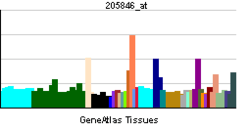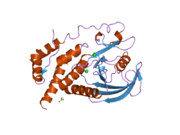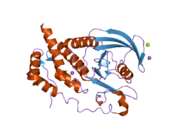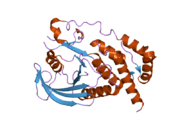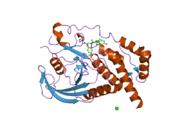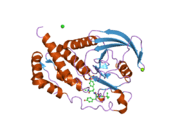PTPRB
Receptor-type tyrosine-protein phosphatase beta or VE-PTP is an enzyme specifically expressed in endothelial cells that in humans is encoded by the PTPRB gene.[1][2]
Function
VEPTP is a member of the classical protein tyrosine phosphatase (PTP) family. The deletion of the gene in mouse models was shown to be emryonically lethal,[3] thus indicating that it is important for vasculogenesis and blood vessel development. In addition it was shown to participate in adherens junctions and regulate vascular permeability.[4]
Interactions
VE-PTP contains an extracellular domain composed of multiple fibronectin type_III repeats, a single transmembrane segment and one intracytoplasmic catalytic domain, thus belongs to R3 receptor subtype PTPs. The extracellular region was shown to interact with the angiopoietin receptor Tie-2.[2] and with the adhesion protein VE-cadherin.[5]
VE-PTP was also found to interact with Grb2 and plakoglobin through its cytoplasmatic domain.
References
- ↑ "Entrez Gene: PTPRB protein tyrosine phosphatase, receptor type, B".
- ↑ 2.0 2.1 Fachinger G, Deutsch U, Risau W (Oct 1999). "Functional interaction of vascular endothelial-protein-tyrosine phosphatase with the angiopoietin receptor Tie-2". Oncogene 18 (43): 5948–5953. doi:10.1038/sj.onc.1202992. PMID 10557082.
- ↑ Bäumer S, Keller L, Holtmann A, Funke R, August B, Gamp A et al. (Jun 2006). "Vascular endothelial cell-specific phosphotyrosine phosphatase (VE-PTP) activity is required for blood vessel development". Blood 107 (12): 4754–62. doi:10.1182/blood-2006-01-0141. PMID 16514057.
- ↑ Broermann A, Winderlich M, Block H, Frye M, Rossaint J, Zarbock A et al. (Nov 2011). "Dissociation of VE-PTP from VE-cadherin is required for leukocyte extravasation and for VEGF-induced vascular permeability in vivo". The Journal of Experimental Medicine 208 (12): 2393–401. doi:10.1084/jem.20110525. PMID 22025303.
- ↑ Nawroth R, Poell G, Ranft A, Kloep S, Samulowitz U, Fachinger G et al. (Sep 2002). "VE-PTP and VE-cadherin ectodomains interact to facilitate regulation of phosphorylation and cell contacts". The EMBO Journal 21 (18): 4885–4895. doi:10.1093/emboj/cdf497. PMID 12234928.
Further reading
- Ramachandran C, Aebersold R, Tonks NK, Pot DA (1992). "Sequential dephosphorylation of a multiply phosphorylated insulin receptor peptide by protein tyrosine phosphatases". Biochemistry 31 (17): 4232–8. doi:10.1021/bi00132a012. PMID 1373652.
- Harder KW, Anderson LL, Duncan AM, Jirik FR (1993). "The gene for receptor-like protein tyrosine phosphatase (PTPRB) is assigned to chromosome 12q15→q21". Cytogenet. Cell Genet. 61 (4): 269–70. doi:10.1159/000133419. PMID 1486802.
- Krueger NX, Streuli M, Saito H (1990). "Structural diversity and evolution of human receptor-like protein tyrosine phosphatases". EMBO J. 9 (10): 3241–52. PMC 552056. PMID 2170109.
- Gaits F, Li RY, Ragab A, Ragab-Thomas JM, Chap H (1995). "Increase in receptor-like protein tyrosine phosphatase activity and expression level on density-dependent growth arrest of endothelial cells". Biochem. J. 311 ( Pt 1) (Pt 1): 97–103. PMC 1136124. PMID 7575486.
- Feito MJ, Bragardo M, Buonfiglio D, Bonissoni S, Bottarel F, Malavasi F et al. (1997). "gp 120s derived from four syncytium-inducing HIV-1 strains induce different patterns of CD4 association with lymphocyte surface molecules". Int. Immunol. 9 (8): 1141–7. doi:10.1093/intimm/9.8.1141. PMID 9263011.
- Nawroth R, Poell G, Ranft A, Kloep S, Samulowitz U, Fachinger G et al. (2002). "VE-PTP and VE-cadherin ectodomains interact to facilitate regulation of phosphorylation and cell contacts". EMBO J. 21 (18): 4885–95. doi:10.1093/emboj/cdf497. PMC 126293. PMID 12234928.
| |||||||||||||||||||||||||||||||
| |||||||||||||||||||||||||||||||

